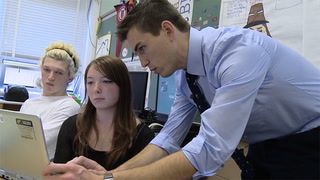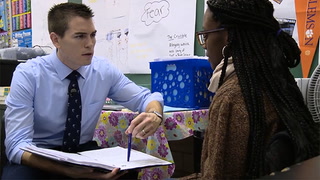Series Getting Better at Personalized Learning : Making Feedback Meaningful
ELA.W.9-10.2a
| Common core State Standards
- ELA: English Language Arts
- W: Writing Standards 6-12
- 9-10: 9th & 10th Grades
-
2a:
Write informative/explanatory texts to examine and convey complex ideas,
concepts, and information clearly and accurately through the effective
selection, organization, and analysis of content.
a. Introduce a topic; organize complex ideas, concepts, and information to
make important connections and distinctions; include formatting (e.g.,
headings), graphics (e.g., figures, tables), and multimedia when useful to
aiding comprehension.
b. Develop the topic with well-chosen, relevant, and sufficient facts, extended
definitions, concrete details, quotations, or other information and examples
appropriate to the audience'\x80\x99s knowledge of the topic.
c. Use appropriate and varied transitions to link the major sections of the text,
create cohesion, and clarify the relationships among complex ideas and
concepts.
d. Use precise language and domain-specific vocabulary to manage the
complexity of the topic.
e. Establish and maintain a formal style and objective tone while attending to
the norms and conventions of the discipline in which they are writing.
f. Provide a concluding statement or section that follows from and supports
the information or explanation presented (e.g., articulating implications or
the significance of the topic).
ELA.W.9-10.5
| Common core State Standards
- ELA: English Language Arts
- W: Writing Standards 6-12
- 9-10: 9th & 10th Grades
-
5:
Develop and strengthen writing as needed by planning, revising, editing,
rewriting, or trying a new approach, focusing on addressing what is most
significant for a specific purpose and audience. (Editing for conventions should
demonstrate command of Language standards 1-3 up to and including grades
9-10 on page 54.)
ELA.W.9-10.8
Common core State Standards
- ELA: English Language Arts
- W: Writing Standards 6-\x80\x9312
- 9-10: 9th & 10th Grades
-
8:
Gather relevant information from multiple authoritative print and digital
sources, using advanced searches effectively; assess the usefulness of each
source in answering the research question; integrate information into the text
selectively to maintain the flow of ideas, avoiding plagiarism and following a
standard format for citation.
Save to My Resources
PLEASE CREATE A NEW ACCOUNT OR LOG IN TO ACCESS THIS CONTENT
Enjoy your first video for free. Subscribe for unlimited access.
Have questions about subscribing?
Click Here to learn more about individual subscriptions.
Click Here to learn more about School and Institution access.
Discussion and Supporting Materials
Thought starters
- How does this feedback strategy help students become more independent learners?
- What structures does Mr. McComb have in place to keep all students engaged and productive?
- How does Mr. McComb use small group instruction to help students make progress towards the standards?
In Partnership With:

School Details
Patapsco High & Center For Arts8100 Wise Ave
Baltimore MD 21222
Population: 1441
Data Provided By:

Teachers
Sean McComb
English Language Arts / 9 10 11 12 / Teacher
Newest
|
4 MIN
|
5 MIN
|
5 MIN
UNCUT CLASSROOMS
| TCHERS' VOICE
English Language Arts












111 Comments
Chantal Walvoord Jan 29, 2024 10:31am
1. The feedback strategies Mr. McComb uses helps students gain ownership over their work. He said in the video he doesn't "want to give them too much." He does not tell them what words to use or which technique to use. Instead, he wants to start their thinking process and give them choices because it is, after all, their voice that should be evident.
2. The structures he uses are the voice notes, the highlights, and the small group conferences.
3. He had small group instruction for students who all have the same difficulties and a one-on-one conference for students who needed additional help and did not feel comfortable with the blog format.
Solomon Asuquo Mar 18, 2022 3:48pm
Feedback is generally essential in managing individuals in every atmosphere as the lack of it might have others working wrongly for a long time, without knowing they're off the track. So, feedback allows, especially students who've always relied on others to see their own strengths and weaknesses and what they could work on. In this manner, they begin to believe in themselves and sharpen their untapped skills.
Mr McComb understands the intrigues of personalized feedback and differentiated instructions, and so, uses it to invest his students.
The small group, personalized instructions grouping allows students to work within their ability levels and increase their chances of improvement.
Irewande Kolawole Mar 14, 2022 1:54pm
He uses feedback to see where improvement is needed. The diferentiated small group mehod also helps to focus on students who students who needs more time and keep everyone fully engaged.
alex jauregui Apr 1, 2021 12:10pm
He reminds me a lot of Carl Anderson - If you want to check out effective feedback or "conferring" with K-8 grade students, check out his book "A Teacher's Guide to Writing Conferences." I just finished a 4 part webinar with him on Heinemann.com and it was amazing. Mr. McComb was just as amazing too!
Dana Williams Nov 13, 2020 8:30am
1. Effective feedback needs to be individualized that meets the needs of a particular student. Using small group instruction for remediation is a good idea. It allows students to work with a mentor in order to better complete assignments. Individualized feedback allows students to understand where improvement is needed. Students will be more receptive to feedback if they feel that they have the opportunity to have their questions answered individually.
2.Mr. McComb effectively uses small group instruction and offers differentiated instructions for all students. He supports peer to peer instruction and provides outlets for independent learning.
3. Mr. McComb uses small group instruction to allow students who are struggling individual time in which he is able to provide feedback to them. His small group instruction also allows for scaffolding of each student.
Aber Patton Jan 29, 2023 10:23am